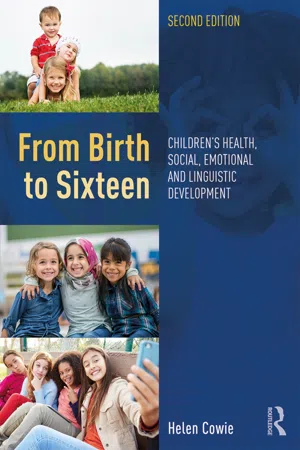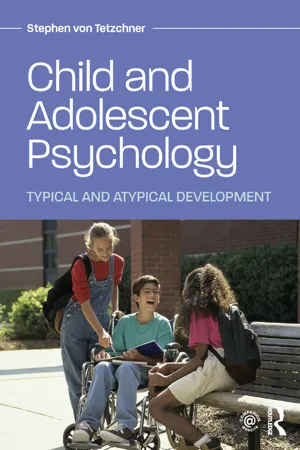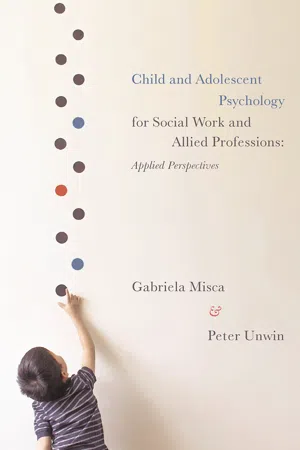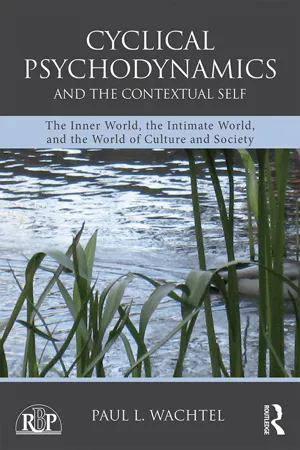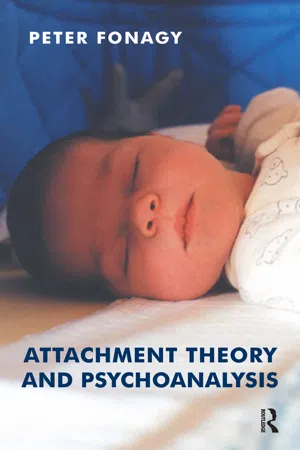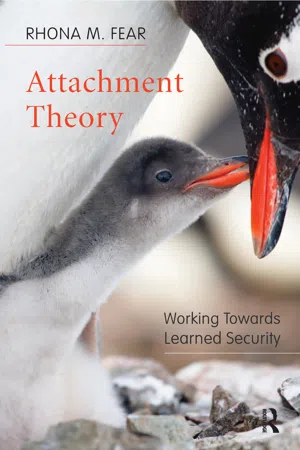Psychology
Attachment
Attachment refers to the emotional bond that forms between an infant and their primary caregiver, typically the mother. This bond is crucial for the infant's emotional and social development, as it provides a sense of security and trust. The quality of attachment can influence the individual's relationships and behavior throughout their life.
Written by Perlego with AI-assistance
8 Key excerpts on "Attachment"
Learn about this page
Index pages curate the most relevant extracts from our library of academic textbooks. They’ve been created using an in-house natural language model (NLM), each adding context and meaning to key research topics.
- eBook - ePub
From Birth to Sixteen
Children's Health, Social, Emotional and Linguistic Development
- Helen Cowie(Author)
- 2019(Publication Date)
- Routledge(Publisher)
Attachment theory , as initially proposed in detail by Bowlby (1969), grounded in his therapeutic work as a child psychiatrist and psychoanalyst. Bowlby’s theory has been greatly extended and refined by his followers. Over the past sixty years, researchers and practitioners have gathered a substantial body of knowledge about the significance of the bond between parents and their children. The concept of Attachment integrates social, emotional and cognitive aspects of the child’s mind.Key concepts in Bowlby’s (1969) original formulation of the theory are affectional bonds , Attachment and Attachment behaviour .• An affectional bond is an enduring emotional tie to a specific individual. A person can be attached to someone who is not in turn attached to him or her.• Attachment is a type of affectional bond characterized by physical proximity-seeking, comfort and security, separation upset and reciprocity.• Attachment behaviour is any form of behaviour that results in a person attaining proximity to some other differentiated and preferred individual usually conceived as stronger and/or wiser; As such, the behaviour includes the following: clinging, crying, calling, greeting, smiling and some more sophisticated forms.Bowlby proposed that the child uses the parent or primary caregiver as a secure base to return to regularly for reassurance. The need to explore takes the infant away from the caregiver and counteracts the need for proximity. A balance is struck between the two opposing tendencies – the need for proximity and the need to explore. In a situation of threat, Attachment behaviours, such as clinging, will be reactivated. Bowlby (1969) described four phases in the development of Attachment (Box 3.1 - eBook - ePub
Child and Adolescent Psychology
Typical and Atypical Development
- Stephen von Tetzchner(Author)
- 2018(Publication Date)
- Routledge(Publisher)
19 AttachmentF rom birth throughout the life span, human beings are oriented toward social stimulation and participation, making social relations a core area of developmental psychology. This chapter is about children’s early social relations and the influence they may have on the child’s social functioning and development. According to Attachment theories, early close relationships provide children with knowledge about social relations that form the basis for how they meet other people and contribute to forming their later reactions and behaviors.Attachment behavior is defined as “any behavior that results in a person attaining or maintaining proximity to some other clearly identified individual who is conceived as better able to cope with the world” (Bowlby, 1982, p. 669). Thus, the function of Attachment behaviors is to ensure a feeling of safety by reducing the physical distance to specific individuals, Attachment figures. If a child’s Attachment system is to perform its function, Attachment figures must respond to the child’s Attachment behavior. Adults react to signaling behavior by reducing the distance to the child when necessary, calling the child or moving closer when the distance exceeds a certain limit, for example when the child has wandered off (Bowlby, 1969).THEORETICAL PERSPECTIVES ON Attachment
Views differ with regard to the basis of Attachment and the possible outcomes of different types of Attachment. John Bowlby presented the first comprehensive theory of Attachment and laid the foundation for all later theories (Hinde, 2005). Bowlby’s ethological theory will therefore be presented first and in particular detail, although some other views predated his.Seeking security by the mother.Ethological theory
Attachment has to do with relationships, whose biological basis, according to Bowlby (1969), is survival. From an evolutionary perspective, the survival value of Attachment behavior lies in the fact that human infants would be unable to survive without a caregiver. The same applies to infant monkeys, although their development is somewhat faster (Suomi, 2008). The imprinting behavior of ducks and other birds seems to fulfill a similar function as Attachment behavior in humans (see Figure 19.1 - eBook - ePub
Child and Adolescent Psychology for Social Work and Allied Professions
Applied Perspectives
- Gabriela Misca, Peter Unwin(Authors)
- 2018(Publication Date)
- Bloomsbury Academic(Publisher)
Attachment theory is a highly influential theory in social work practice, specifically in the area of practice with children and families. Its popularity with social work can be traced back to its roots: original ideas of Attachment theory spoke of maternal deprivation and proposed explanations of behaviour based on our early experiences and quality of relationship and/or separation from our primary carers: the mothers (see Bowlby, 1980). At the centre of social work practice with children and families is the endeavour to support children being cared for within their (birth) families, although many of the children that social workers are working, or will work, with are unable to live with their birth parents. What these children have in common is that they have had their primary Attachment bonds interrupted. It is therefore intuitive to make the link between these early experiences of separation and loss and their later adjustment. Recent government policy (Unwin & Misca, 2013) has promoted adoption as the preferred choice for children at risk as compared to previous practices and policies that have given parents several attempts at rehabilitation. The belief in the critical need for stable early Attachment is a key underpinning theory behind this policy change.John Bowlby is the originator of Attachment theory and its core tenet that the early Attachment of infants to their caregiver is the outcome of an evolutionary mechanism designed not only to guarantee the survival of the dependent and vulnerable infant but also to provide enduring psychological connectedness between human beings (Bowlby, 1980). Attachment theory puts the emphasis on the role of early experiences in shaping the expectations and beliefs a child constructs concerning the trustworthiness and responsiveness of significant others. According to the theory, a person who is cared for in a consistent and responsive manner forms the expectation that others will be both available and supportive when needed (Ainsworth, 1979). Such expectations, or internal working models (IWMs), not only influence the way through which people regulate their emotions but also they can determine to a great extent an individual’s social development and interpersonal relationships in later life. In Bowlby’s view, these working models of relationships become slowly stable and unconscious over time. As individuals use these models as the basis for their interpersonal behaviours, expectations and interpretations, so they become resistant to change (Bowlby, 1980). - eBook - ePub
Cyclical Psychodynamics and the Contextual Self
The Inner World, the Intimate World, and the World of Culture and Society
- Paul L. Wachtel(Author)
- 2014(Publication Date)
- Routledge(Publisher)
to someone or something. And the nature of that Attachment depends on the particular Attachment object being referred to.But more than that, it depends on the context even with regard to the Attachment to a particular figure. That is, the idea of secure or insecure Attachment, or of ambivalent, avoidant, or disorganized Attachment, ultimately refers to statistical probabilities, to what usually occurs. No one is simply securely or insecurely attached, even with regard to a single Attachment figure. We describe someone as securely attached when he is mostly securely attached – either in the sense of being securely attached to most of his Attachment figures or in the sense of being securely attached to any particular Attachment figure most of the time. But every single securely attached individual will look in securely attached some of the time, and every single insecurely attached individual will look securely attached some of the time.This is not just a matter of measurement error or of trivial occasional deviations. Attention to these differences and variations is critical to promoting therapeutic change. It is part of a larger focus on the variations in behavior and experience that our patients inevitably manifest and that, if we can attune ourselves to noticing them, enables us to find the kernels of new ways of being and help our patients to develop alternative modes of behavior and experience to those that have been responsible for perpetuating their difficulties (Wachtel, 2008, 2011a). Successful therapeutic work is impeded by ways of thinking that obscure these variations and these kernels of new possibility – by the tendency to pathologize and the tendency to describe personality in terms of acontextual “inner” structures rather than in terms of contextual structures that must be understood in relation to the events and personal transactions that frame the person’s life. - eBook - ePub
- Peter Fonagy(Author)
- 2018(Publication Date)
- Routledge(Publisher)
1 Introduction to Attachment TheoryAttachment theory is almost unique among psychoanalytic theories in bridging the gap between general psychology and clinical psychodynamic theory. Many have noted the gulf that exists to this day between theories of the mind that have their roots in empirical social science (largely psychological research), and clinical theories that focus on the significance of individual experience in determining life course, including psychopathology. Paul Whittle (in press) recently described this discontinuity of theories as a fault line that runs across the entire discipline of psychology. Indeed, it is easy to discern the fault line between the tectonic plates of psychoanalysis, where giving meaning to experience is seen as the primary cause of behavior as well as the royal road to its therapeutic change, and the abutting plate of experimental psychology, with its emphasis on parsimony, insistence on reliable observation, and abhorrence of rhetoric and speculative theory-building. Yet Attachment theory has a home on both sides of the fault line. How can this be?John Bowlby’s work on Attachment theory started when, at the age of 21, he worked in a home for maladjusted boys. Bowlby’s clinical experience with two boys, whose relationships with their mothers were massively disrupted, made a profound impact on him. A retrospective study he carried out ten years later, examining the history of 44 juvenile thieves (Bowlby 1944), formalized his view that the disruption of the early mother–child relationship should be seen as a key precursor of mental disorder. The one factor that distinguished the thieves from the clinic children was evidence of prolonged separation from parents, particularly striking among those whom he termed “affectionless.” In the late ’40s Bowlby extended his interest in mother–infant relations by undertaking a review of research findings on the effects of institutionalization on young children (Bowlby 1951). Children who had been seriously deprived of maternal care tended to develop the same symptoms as he had identified in his “affectionless” young thieves. While giving central place to parenting in general and the infant–mother relationship in particular, the 1951 monograph was silent on the mechanisms by which maternal deprivation might be expected to generate adverse consequences. The maternal deprivation literature was itself wide open to alternative interpretations, particularly ones that deemphasized the mother-infant bond (e.g., Rutter 1971). At about the same time, James Robertson, with Bowlby’s encouragement, spent 4 years documenting on film the impact on 18- to 48-month-olds of separation from the parents during an episode of hospital admission or admission to residential nurseries (Robertson 1962). Later, more systematically collected behavioral observations and descriptions that fully confirmed the Robertson material were collected by Christopher Heinicke (Heinicke and Westheimer 1966). - Daniel P. Keating, Hugh Rosen(Authors)
- 2013(Publication Date)
- Psychology Press(Publisher)
What remains to be explored is how other dimensions of the parent–child relationship gradually develop and assume importance along with the security issues related to Attachment system functioning. Parents assume multidimensional roles in relation to their children, of course. They are not only Attachment figures but also significant play partners, teachers and consultants; catalysts for the introduction of new experiences, interests, and competencies; mentors; distributors of resources that are of value to the child; and, in their use of discipline and maturity demands, parents are sometimes frustrators of the child's wishes and desires. When siblings are involved, parents are also mediators, negotiators, and arbitrators. Although security issues related to Attachment probably remain important throughout the lifespan, their preeminence in the parent–child relationship undoubtedly changes as the nature of parent–child interaction becomes more multifaceted and multidimensional. In exploring developmental changes in the Attachment system, therefore, researchers will err if they focus exclusively on the kinds of issues that remain consistent in the representation of Attachment over developmental time. Indeed, a focus on consistent features of Attachment representations may be additionally misleading if it does not recognize that the meaning of relational “security” is radically different to an adult reflecting on Attachment issues compared to a baby. Understanding the place of Attachment in the developing parent–child relationship remains the most important and unaddressed issue in the growth of Attachment theory.CONCLUSION
This portrayal of the construction and reconstruction of early social Attachments has emphasized the flexibility rather than the resiliency of infantile bonds and their current and future consequences. It derives not only from an appreciation of the relative simplicity of early conceptual systems relating to self and other, and the multidetermined, dynamic quality of the emotional underpinnings of Attachment system functioning, but also from a review of research on Attachment in which plasticity and change in the security of Attachment is as apparent as stability and prediction to later behavior. In general, when the security of Attachment has been related to later sociopersonality functioning, it has probably been due to the maintenance of consistent patterns of parent–child interaction that provides continuing support for the child's functioning rather than due to enduring internalized models of self and other, or emergent patterns of personality organization. This perspective does not argue that the child does not play an active role in the construction of relationships but that the child's role becomes progressively more refined and influential with development as the child acquires the cognitive capacities necessary to generate elaborated representations of relationships. Prior to this time, early working models of self and other derived from significant caregiving relationships are likely to be flexible and provisional, and the emotional processes regulating Attachment behaviors more plastic. Even so, the infant assumes an early and active role in the construction of Attachment relationships through the development of rudimentary relational expectations, the exercise of affective self-regulation related to Attachment system functioning, and the child's own dispositional characteristics. It is, in short, the interaction- eBook - ePub
- John Bowlby(Author)
- 2012(Publication Date)
- Routledge(Publisher)
7 The Role of Attachment in Personality Development DOI: 10.4324/9780203440841-7Evidence regarding the role of Attachment in personality development has been accumulating apace during the 1980s. Earlier findings have been replicated on samples of diverse origin; methods of observation have been refined and new methods introduced; and the role of easy two-way communication between parent and child in making for healthy emotional development has been emphasized. Since I believe this new work to have far-reaching clinical implications, my aim in this lecture has been to present a review of these findings in a form suited to those working as psychotherapists in the mental health field.For the convenience of the reader I begin by restating in summary form some of the features most distinctive of Attachment theory.Some Distinctive Features of Attachment Theory
It will be remembered that Attachment theory was formulated to explain certain patterns of behaviour, characteristic not only of infants and young children but also adolescents and adults, that were formerly conceptualized in terms of dependency and over-dependency. In its original formulation observations of how young children respond when placed in a strange place with strange people, and the effects such experiences have on a child’s subsequent relations with his parents, were especially influential. In all subsequent work theory has continued to be tied closely to detailed observations and interview data of how individuals respond in particular situations. Historically the theory was developed out of the object-relations tradition in psychoanalysis; but it has drawn also on concepts from evolution theory, ethology, control theory, and cognitive psychology. One result is the reformulation of psychoanalytic metapsychology in ways compatible with modern biology and psychology and in conformity with the commonly accepted criteria of natural science (see Lecture 4). - eBook - ePub
Attachment Theory
Working Towards Learned Security
- Rhona M. Fear(Author)
- 2018(Publication Date)
- Routledge(Publisher)
are best suited to an experience of living with two parents, for unless this occurs the child cannot work through the Oedipus complex, during which he at first wants to separate his parents, one from the other, and eventually learns with relief that he has been unable to achieve this ideal, which would actually have caused heartbreak. I think that it will be apparent that I believe that this period of intrapsychic conflict is seminal in the child’s development.Additionally, children are best suited to living in homes with their parents, or at least with a “significant other” (perhaps a grandmother, for example) that they can call their own. This helps to provide what Bowlby came to call “a secure base”. He went on to realise that Attachment behaviour involves a need to keep proximity to one’s Attachment figure. He said, “All of us, from the cradle to the grave, are happiest when life is organised as a series of excursions, long and short, from the secure base provided by our Attachment figures” (Bowlby, 1988, p. 62).Essentially, Attachment theory is a spatial theory, involving the need to keep the Attachment figure at a distance that the individual finds comfortable. This might mean a literal distance, or, as Holmes designates it, an invisible “Maginot line” (Holmes, 1993, p. 70) as can be seen in the child at playgroup who plays with his chums, somewhat in parallel play, a few feet away from mum, and regularly comes back to check her out, and tug on her skirts in order to gain reassurance. Alternatively, it might mean proximity in a more sophisticated and abstract form, where a photograph of a loved one suffices, or even the holding on to a transitional object. I have known clients of mine, deep in a dependent transference, keep by their sides a book that I might have lent them, or even go to sleep at night with one of my business cards clutched in their hand.I would wish, however, to take issue with Bowlby’s dictum that living with two parents is always best. Living with two parents is best if the parents are enjoying a close relationship. Sadly, this is not always the case. I have borne witness to many clients’ complaints that they wished their parents had divorced earlier because they suffered the effects of seemingly interminable aggressive conduct (both emotional and physical). I took issue with a BBC Panorama programme, the tenet of which was, unsurprisingly, that living with two parents was preferable for a child’s development. Yes, this is so, but with one proviso: only if
